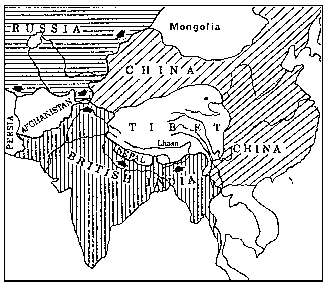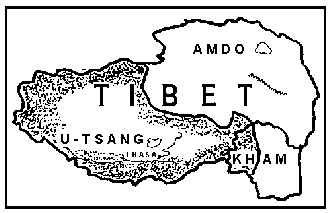Tibet: Friends of Tibet
Until 1950 Tibet was a sovereign state of three provinces inhabited by six million people with a distinct language, culture and history dating back thousands of years. In 1950 Tibet was invaded by the army of her neighbour: The People 's Republic of China
LOOK
What has happened to TIBET since then:
- 1.2 million Tibetans died as a result of Chinese occupation
- Over six thousand monasteries, temples and historical structures looted and destroyed
- Tibet's ecosystem has been severely damaged: vast tracts of forest have been denuded, wildlife species decimated
- Tibet's substantial mineral resources have been plundered
- One quarter of China's nuclear missiles are stationed in Tibet
- China is using Tibet as a dumping ground for nuclear waste
- Some three hundred thousand Chinese troops are based in Tibet (1 soldier to every 10 Tibetans)
- 7.5 million Chinese colonists have been shifted into Tibet in a move to dominate the Tibetans
- A secret Chinese document in 1992 revealed plans to swamp the Tibetan population with even more Chinese.
- Forced abortions, many in late pregnancy, and sterilization of Tibetan women is common.
- Some four thousand Tibetan political prisoners are being held
- 175,000 Tibetans are in exile.
- In 1959, the lnternational Commission of Jurists found that genocide had been committed in Tibet.
The Tibetan peoples' struggle has been non-violent for over forty years and their courage in the face of sustained persecution and world-wide apathy truly deserves the support of those with the freedom to do so.

Map showing Tibet and her powerful neighbours at the end ofthe l9th Century.
China has redrawn Tibet's boundaries so that which China refers to as the Tibet Autonomous Region now appears to be less than half its original size and has rewritten Tibet's history books to justify its claim to Tibetan territory.

The shaded area refers to the so-called Tibet Autonomous Region (since l965).
The UN General Assembly passed three resolutions in 1960, 1961 and 1965, condemning China for violation of Fundamental Human Rights of the Tibetan people and called on China to respect the Tibetan peoples' rights, including their right to self determination.
His Holiness the Dalai Lama, the leader of the Tibetan people, has made a number of overtures to the Chinese Government, including the Five Point Peace Plan in 1987, and the Strasbourg Proposal a year later, but has met with silence from China.
FIVE POINT PEACE PLAN
- The transformation of the whole of Tibet into a zone of peace;
- Abandonment of China's population transfer policy which threatens the very existence of the Tibetans as a people;
- Respect for the Tibetan peoples' fundamental human rights and democratic freedoms;
- Restoration and protection of Tibet's natural environment and the abandonment of China's use of Tibet for the production of nuclear weapons and dumping nuclear waste;
- Commencement of earnest negotiations on the future status of Tibet and of relations between the Tibetan and Chinese peoples.
STRASBOURG PROPOSAL
At the European Parliament in Strasbourg on June 15, 1988 His Holiness gave a speech which became known as the Strasbourg Proposal. His Holiness elaborated on the Fifth Point of his Peace Plan which called for earnest negotiations between the Tibetans and the Chinese. He said "We have taken the initiative to formulate some thoughts which, we hope, may serve as a basis for resolving the issue of Tibet."
These included : the whole of Tibet including U-Tsang, Kham, and Amdo should be a self governing political entity in association with the People's Republir of China with a popularly elected head of government; China would remain responsible for Tibet's foreign policy; a regional peace conference be called to ensure that Tibet becomes a genuine sanctuary of peace; strict laws would be passed to protect wildlife and plantlife, and the manufacturing and storing of nuclear weapons or waste would be prohibited.
In 1994, after having no response from the government of the Peoples' Republic of China, His Holiness withdrew his Strasbourg Proposal in relation to Tibet's autonomy within China and China's having control of Tibet's foreign policy.
What is needed is for foreign governments to persuade China to begin earnest negotiations with His Holiness and His representatives to find a peaceful solution to Tibet.
The United States Congress and the Australian Senate have passed Resolutions in 1993 declaring Tibet an occupied country, and the European Parliament has declared its support for Tibet.
Friends of Tibet (NZ) was established in 1988 in Auckland to let New Zealanders know of the plight of the Tibetan people.
Friends of Tibet (NZ) is actively encouraging the New Zealand Parliament to re-recognise Tibet as an occupied country, which it had done prior to China's admission to the United Nations in 1972.
Friends of Tibet has also established a multi-party Parliamentary Lobby Group for Tibet in New Zealand.
![]() Tibetan National flag which if displayed today in Tibet means a prison sentence of up to 15 years. About the Tibetan flag
Tibetan National flag which if displayed today in Tibet means a prison sentence of up to 15 years. About the Tibetan flag
Here's what you can do:
- Join Friends of Tibet (NZ) and keep yourself informed of current events in New Zealand and internationally relating to the Tibetan cause. You will receive a bi-monthly newsletter. Membership is only $20 annually. Become active in your local branch.
- Become a sponsor of a Tibetan refugee child in India through Friends of Tibet, who will connect you with the Tibetan Children Relief Society, which was set up for the purpose of helping Tibetan refugee children's education.
- Write to your local M.P. asking him or her to join the Parliamentary Lobby Group for Tibet, and take an interest in the issue of Tibet.
To join click HERE.
Δεν υπάρχουν σχόλια:
Δημοσίευση σχολίου